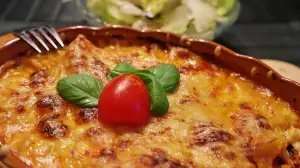Master the Art of Making Crispy Latkes: A Delicious Dive into Jewish Cuisine

Latkes are a beloved dish in Jewish cuisine, typically enjoyed during Hanukkah, the Festival of Lights. These crispy potato pancakes are a staple at Jewish holiday celebrations and family gatherings. They are made from grated potatoes, onions, eggs, and flour, seasoned with salt and pepper, then fried to golden perfection. The aroma of sizzling latkes is enough to make anyone's mouth water. Whether served as an appetizer or side dish, latkes are a delicious treat that brings people together around the table.
Origins of Latke in Jewish Cuisine
The origins of latkes can be traced back to Jewish cuisine, particularly during the holiday of Hanukkah. The tradition of eating fried foods like latkes is symbolic of the miracle of the oil that burned for eight days in the ancient Temple in Jerusalem. Latkes have become a staple dish during Hanukkah celebrations, symbolizing the importance of oil in Jewish history and culture. Over time, latkes have evolved into a beloved dish enjoyed not only during Hanukkah but throughout the year in Jewish households and beyond.
Key Ingredients for Making Latke
The key ingredients for making delicious latkes include potatoes, onions, eggs, flour or matzo meal, salt, and pepper. Potatoes are the star of the dish and should be grated finely to achieve a crispy texture. Onions add flavor and moisture to the latkes. Eggs act as a binding agent, while flour or matzo meal helps hold the mixture together. Salt and pepper are essential for seasoning the latkes to perfection. Some recipes may also call for additional ingredients like garlic or herbs to enhance the flavor profile of the dish.
Traditional Cooking Methods for Latke
The traditional method of cooking latkes involves frying them in oil until they are golden and crispy. The oil should be hot enough to create a sizzling sound when the latke is added to the pan, ensuring a crunchy exterior. It is important to use a neutral oil with a high smoke point, such as vegetable or canola oil, to achieve the desired texture without imparting any unwanted flavors. Some recipes call for shallow frying, while others recommend deep-frying for an extra crispy finish. Whichever method you choose, be sure to drain the latkes on paper towels after cooking to remove excess oil and keep them light and crisp.
Variations of Latke in Different Cultures
Variations of Latke can be found in different cultures around the world, each with its own unique twist. In Russia, draniki are similar to latkes but are often made with grated potatoes and onions. In India, aloo tikki is a popular street food made from mashed potatoes and spices. In Korea, gamja-jeon are potato pancakes seasoned with salt and scallions. Even in the United States, sweet potato latkes have become a trendy alternative during Hanukkah. These variations showcase the versatility of this beloved dish across diverse culinary traditions.
Serving Suggestions and Accompaniments for Latke
When it comes to serving latkes, there are endless possibilities to elevate this classic dish. A popular choice is to pair them with a dollop of sour cream or applesauce, which adds a creamy or sweet contrast to the crispy texture of the latke. For a more savory option, you can top your latkes with smoked salmon and a sprinkle of fresh dill for a luxurious twist. Another creative idea is to serve them with a side of homemade tzatziki sauce for a Mediterranean flair. No matter how you choose to serve your latkes, they are sure to be a hit at any gathering or meal.
Health Benefits of Latke
Despite being a fried dish, latkes can offer some health benefits when prepared mindfully. Potatoes, the main ingredient in latkes, are a good source of vitamins C and B6, potassium, and fiber. When cooked properly, they can retain these nutrients. Additionally, onions used in latkes contain antioxidants and anti-inflammatory properties that can benefit overall health. By using healthy cooking oils and moderating portion sizes, you can enjoy the delicious flavors of latkes while still maintaining a balanced diet.
Tips for Perfecting Your Latke Recipe
1. Grate the potatoes and onions by hand for the best texture. Using a food processor can result in a mushy consistency.
2. Squeeze out as much liquid as possible from the grated potatoes and onions to ensure crispy latkes.
3. Use a high-starch potato variety like Russet or Yukon Gold for a fluffy interior and crispy exterior.
4. Add a binding agent like flour or matzo meal to help hold the latkes together during frying.
5. Fry the latkes in hot oil, around 350-375°F (175-190°C), to achieve a golden-brown crust.
6. Avoid overcrowding the pan while frying to allow proper circulation of heat and ensure even cooking.
7. Drain the cooked latkes on paper towels to remove excess oil before serving.
8. Serve latkes immediately after cooking for the best taste and texture.
By following these tips, you can elevate your latke-making skills and impress your guests with perfectly crispy and delicious latkes every time!
In conclusion, mastering the art of making crispy latkes is a delightful journey into Jewish cuisine that offers a blend of history, tradition, and flavor. Whether enjoyed during Hanukkah or as a comforting dish year-round, latkes bring people together through their crispy exterior and soft interior. By understanding the origins, key ingredients, cooking methods, and variations of latkes, you can create restaurant-quality food at home. Remember to experiment with different toppings and accompaniments to elevate your latke experience. With practice and attention to detail, you can perfect your latke recipe and impress your family and friends with this delicious dish.
Published: 02. 04. 2024
Category: Food



